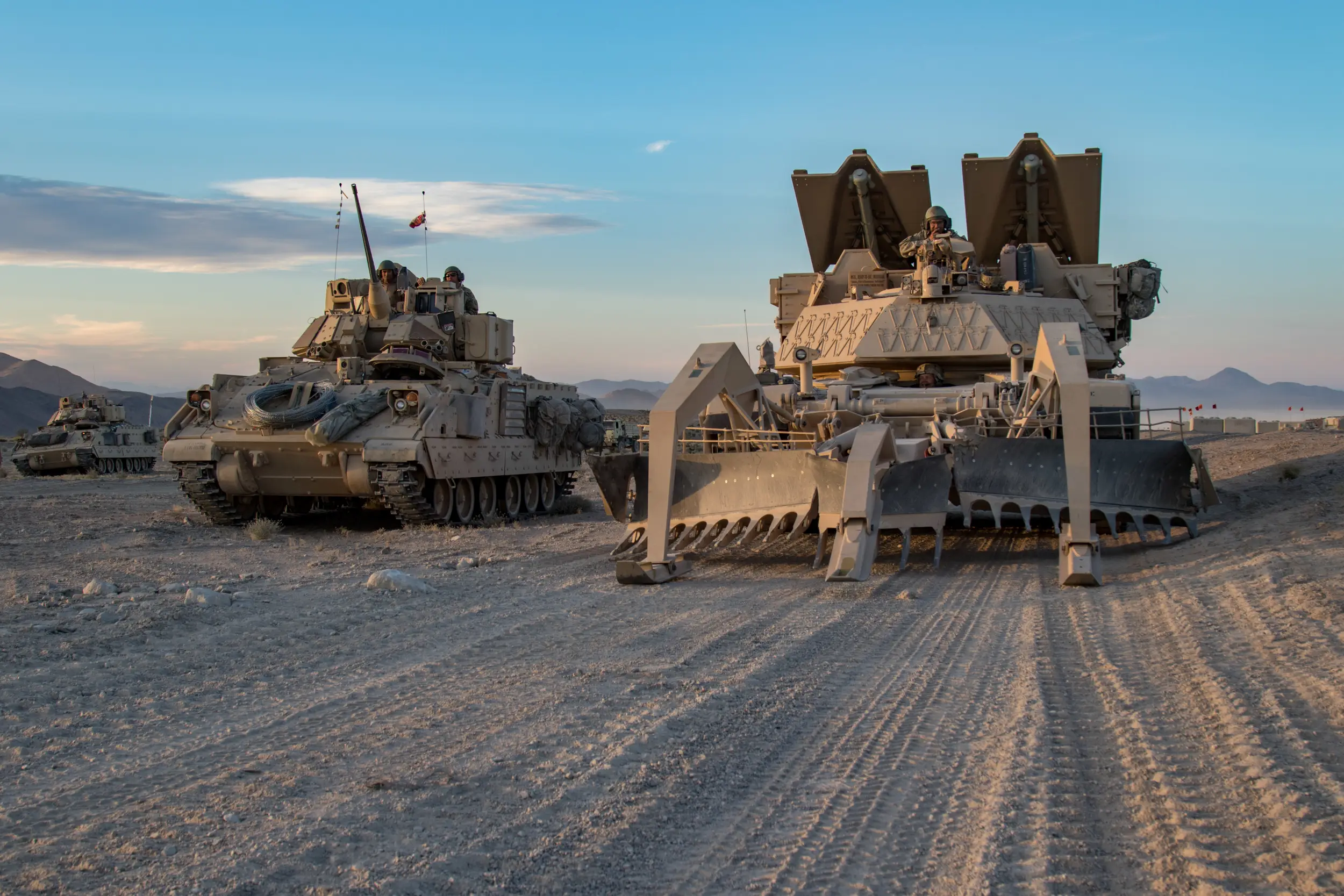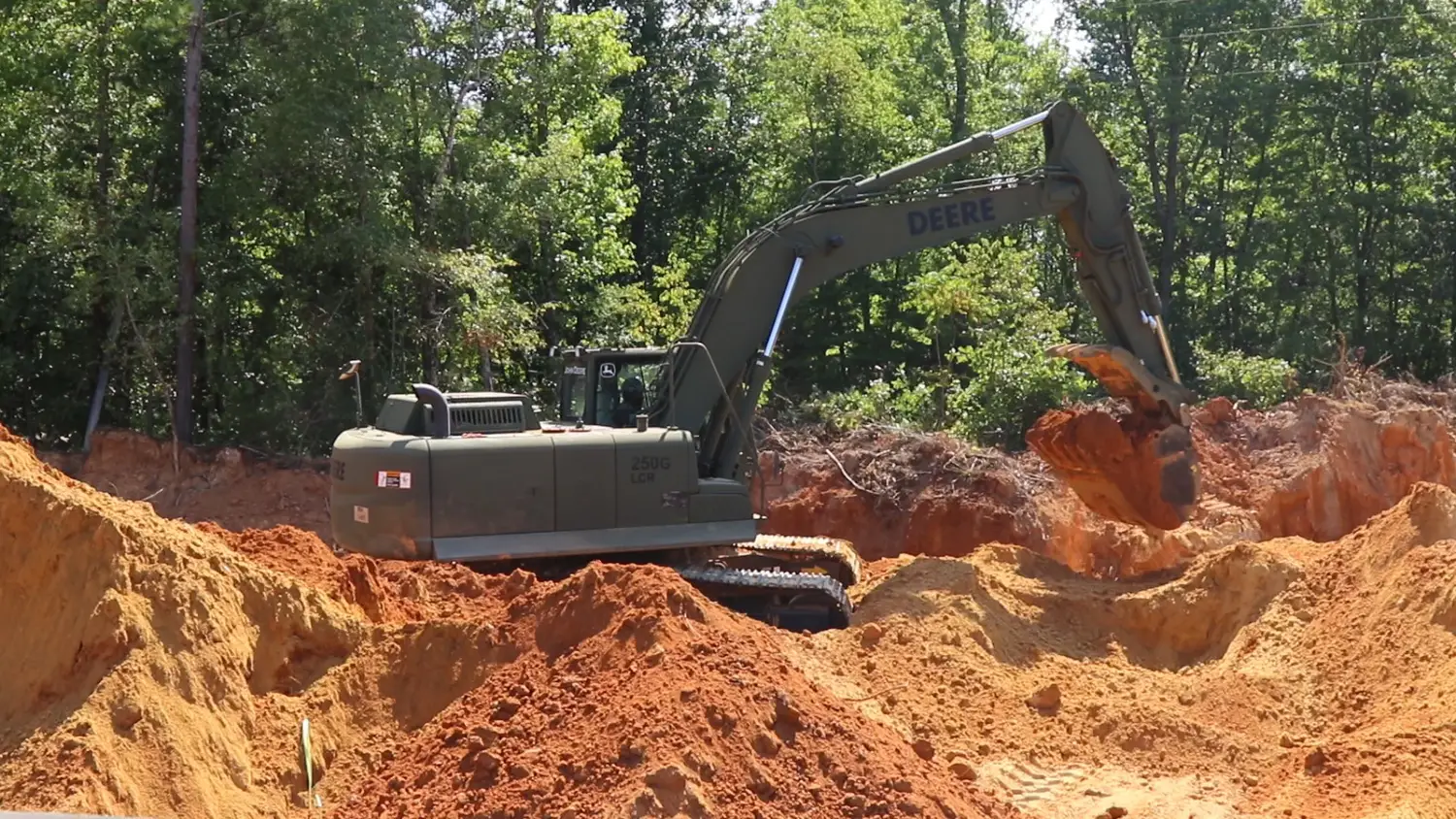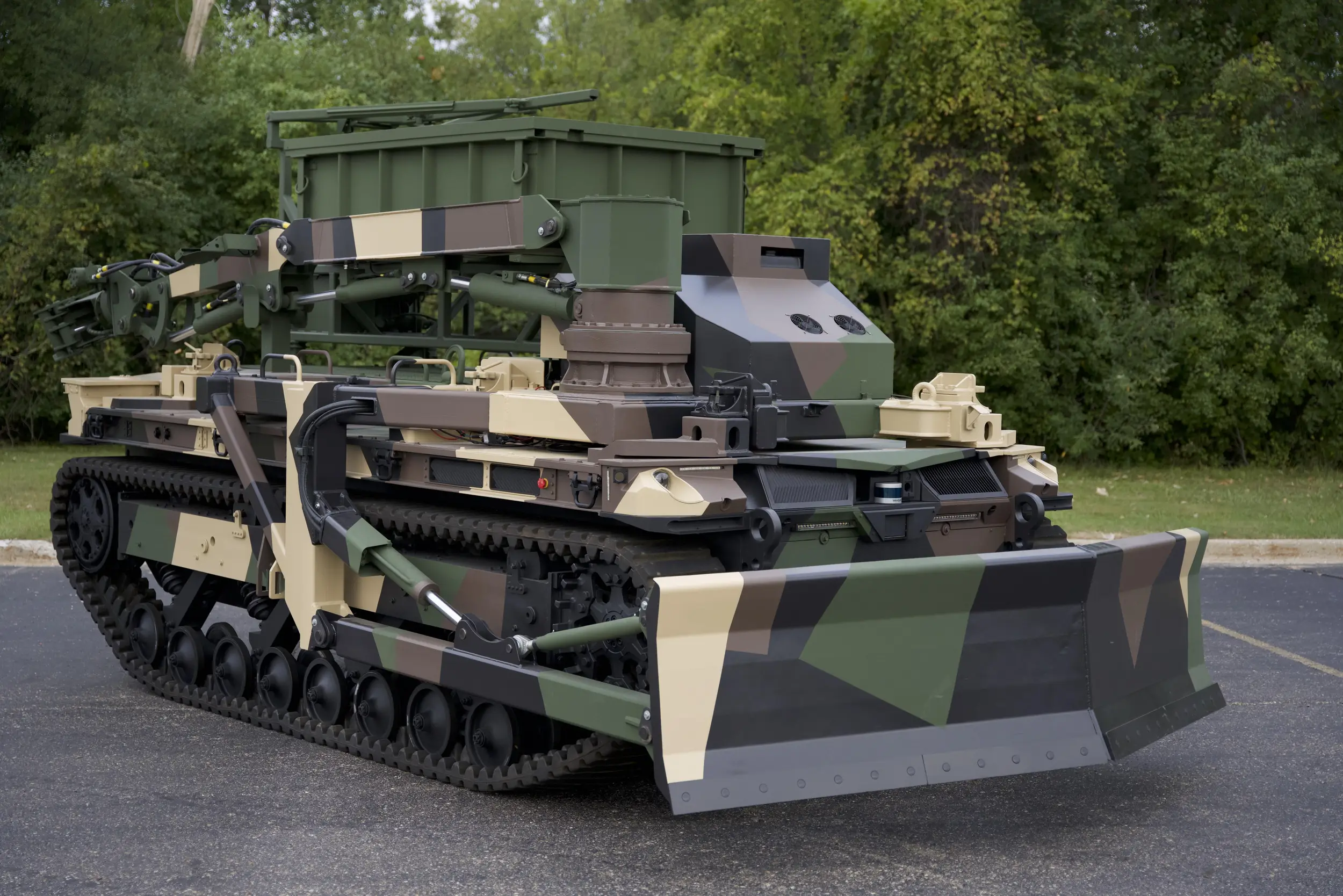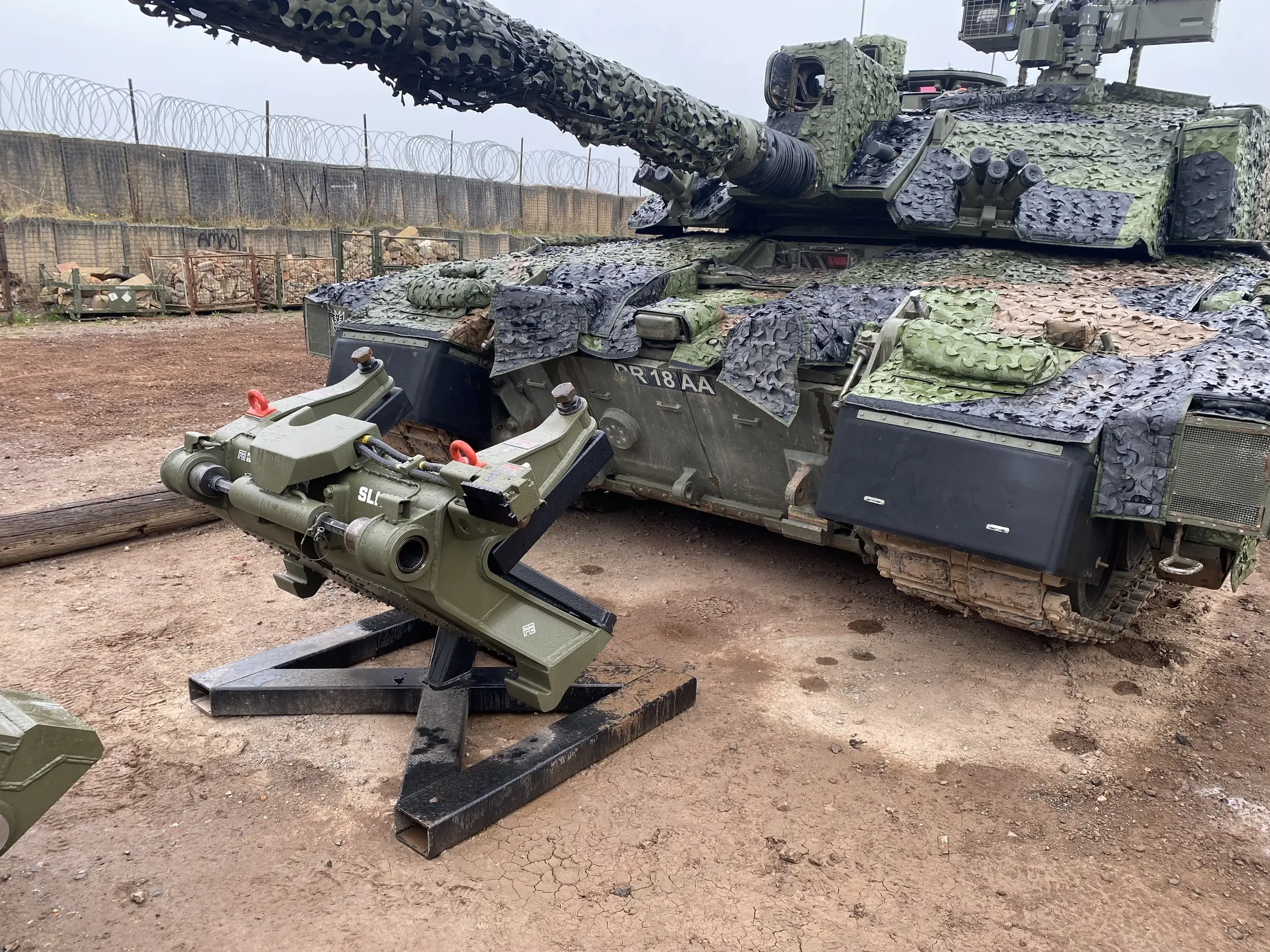
REPORT HOME > sharing the load
MAY 2024 | technology report | Armoured vehicles
Specialist combat engineering vehicles have traditionally been heavy, expensive and procured in relatively small numbers. Shephard looks at fresh approaches to growing this capability at a lower cost, including using smaller base platforms, and the development of rapid conversion kits to enable standard AFVs to carry out missions such as breaching or mine clearance.
Above: The US Army is currently exploring remote-control capabilities for its M1150 Assault Breacher Vehicle, one of relatively few dedicated AEVs in widespread service (Photo: US Army)
Combat engineering is a vital task for modern armies, whether conducted by specialised vehicles or delivered by adapted platforms. How could the area develop as the battlespace evolves into the future?
Combat engineering vehicles (CEVs) or armoured engineering vehicles (AEVs) today fulfil a range of vital tasks, such as breaching; they also act as excavators and bulldozers and perform mine clearance, among other support and construction tasks.
Seeking innovation
Christopher F Foss is an internationally recognised authority on AFV and other weapon systems and the author of Shephard’s Decisive Edge: Land Warfare newsletter.
He said that although CEVs and AEVs conduct a wide range of vital roles, the vast majority of nations do not operate a specialised vehicle in the category, with some exceptions, such as the Terrier AEV used by the British Army’s Royal Engineers.
‘That is a very expensive and complicated vehicle, sometimes called a Swiss Army Knife because they do so many things with it,’ Foss said.
Instead, most nations use adapted main battle tanks (MBTs) and other vehicles to fulfil their engineering needs, perhaps fitting them with a dozer blade, a mine clearing device or similar of equipment, Foss explained.
In terms of potential innovation, he said remote-control capability has applications in high-threat areas, such as mine clearance. Further down the track, ‘it will be interesting to see how artificial intelligence (AI) fits into the picture’.
Rae Higgins, public affairs officer for the US Army’s Program Executive Office – Combat Support & Combat Service Support (PEO CS&CSS) said the organisation is indeed currently exploring remote-control capabilities for the M1150 Assault Breacher Vehicle (ABV).
The ABV Remote Control System (RCS) will provide a fully tracked combat engineer vehicle to breach minefields and complex obstacles, providing an in-stride capability for Armored Brigade Combat Teams.
The RCS capability ‘will provide soldier offset to reduce casualties’, Higgins explained. There is also the ability to integrate other attachments, such as an excavator arm, magnetic signature duplicator or mine rollers.
‘The [ABV RCS] is currently in prototype phase with planned testing, maturation and engineering efforts in FY24 through FY27,’ she added.
Breaching is one of the most dangerous ground operations and requires speed of manoeuvre and innovative approaches, said Higgins. The ABV is a highly mobile, fully tracked and heavily armoured minefield and complex obstacle breaching system, offering ‘crew protection and vehicle survivability comparable to the M1A1 Abrams tank chassis, while having the speed and mobility to keep up with the manoeuvre force’.
The theme of remote control for engineering tasks is an important focus for the US Army. Higgins also pointed to the M160 Remote Control Anti-Personnel Mine Clearing System, a tele-operated light flail ‘designed to provide line-of-sight unmanned mine-clearing operations. It clears land and counters the effects of landmines that could impede mobility, destroy systems, or cause personnel casualties’.’
Flexible capability
Adaptability is clearly a key theme in combat engineering today, and likely to remain so in future. Higgins also identified a range of systems that provide armoured engineering capabilities without being considered full-blown AEVs. One example is the Family of All-Terrain Cranes (FoATC), which provides armour protection for select Type II cranes as an add-on kit.
This enables horizontal, vertical and engineer construction, and provides specialist support companies ‘with the capability necessary to conduct overhead lift, container moving, pile driving, resupply activities and general construction tasks’, Higgins said, along with work such as upgrading and repairing facilities, airfields and roads.
Higgins also highlighted the Army’s family of dozers, which provides combat engineer, quartermaster and transportation companies with the capability to construct and maintain infrastructure, breaching operations, the emplacement of bridging systems and more. It is considered critical dual-use equipment, she said.
Additionally, she showcased the army’s Heavy Scraper, which provides armoured capabilities for select Scrapers, again as an add-on kit. ‘The Heavy Scraper enables current and future multi-domain manoeuvre force by equipping engineer support, horizontal construction and vertical construction companies with the earthmoving capability necessary to construct, maintain and repair airfields, runways, taxiways and parking aprons, main supply routes, logistical facilities, roads, helipads, motor pools, railroads and ports of entry/debarkation,’ she noted.
Above: Many US Army engineering systems such as the Hydraulic Excavator can be adapted for combat use by adding armour kits. (Photo: US Army)
Other examples of equipment with significant engineering applications, include the Vibratory Roller, which also be up-armoured via an add-on kit, as can the Hydraulic Excavator (HYEX).
The add-on kit for the latter is designed with adaptability for combat engineering firmly in mind, as it provides ‘the capabilities necessary for rapid airfield damage repair, wet gap crossing, ground line of communication construction, building and descoping of bases, barriers and obstacles, survivability missions, and infrastructure and facility repair,’ said Higgins.
Finally, she pointed to the High Mobility Engineer Excavator (HMEE), for which an add-on kit also exists. The HMEE-IV enables current and future multi-domain manouevre, Higgins said, by equipping airborne, construction and combat engineer units with the capabilities to conduct light earthmoving, loading and excavation throughout the area of operations in support of activities such as airfield and road repair or construction, the preparation of bridge sites and more.
‘It is self-deployable and used to repair lines of communications, resulting in increased force mobility, manoeuvrability, deployability and sustainability,’ Higgins said, noting that the HMEE-IV can travel up at to 60mph on primary roads and 25mph on secondary roads, keeping pace with US Army’s combat systems.
Uncrewed options
General Dynamics Land Systems (GDLS) does not produce AEVs per se, although the company is working on UGVs that could perform some of their tasks. For instance, the Tracked Robot 10-ton (TRX) is designed to support a range of heavy-lift missions, said Ray Moldovan, business development manager at GDLS.
Above: GDLS is working on large UGVs that could perform some of the tasks conducted by AEVs. (Photo: GDLS)
The advantage of UGVs in noncombat support roles, including engineering, is manifold, Moldovan said. They achieve a force-multiplying effect by minimising the amount of personnel required to perform missions. They also reduce logistics burdens, as a base mobility platform – such as TRX – can be a common element used to deploy a diverse set of capabilities to battlefield commanders.
More widely, Moldovan said that it is clear that adapting AEVs with drive-by-wire kits and autonomous capabilities ‘will expand their effectiveness in the battlespace for the same reasons that UGVs increase the combat effectiveness of traditionally equipped forces’.
Adoptive approach
A major focus of innovation in combat engineering will remain the need to adapt vehicles for use in engineering tasks, even if this is not their original purpose. A spokesperson for Pearson Engineering noted that ‘combat engineers cannot be omnipresent and often suffer a lack of funding, which means that skilled personnel and assets are stretched across conflict environments’.
Against the backdrop of a wider shift towards multi-domain operations, Pearson Engineering is promoting a flexible approach, for example through its SLICE concept, which aims to enable a wider range of vehicles to undertake engineering tasks, leaving dedicated AEVs to deal with the most specialist and complex work.
SLICE is designed to enable MBTs and other AFVs to quickly fit, operate and remove a wide range of front-end equipment, including mine ploughs and dozer blades, according to Pearson Engineering .
It uses a lightweight interface that can be fitted without permanent modification to the host vehicle, avoiding any impact on survivability. In essence, the idea is that a mine plough usually deployed by a dedicated engineering vehicle – and which is already available in the inventory – could instead be utilised by an MBT as required.
Above: Pearson Engineering is promoting a flexible and adaptable approach through its SLICE concept, which aims to enable a wider range of vehicles to undertake engineering tasks. (Photo: Pearson Engineering)
According to Pearson Engineering , SLICE can be added or removed from the MBT in about 15 minutes, using a crane and basic tools. Front-end equipment can then be quickly fitted onto SLICE in field conditions, without the requirement for additional tools.
‘Whilst it could be considered a simple vehicle interface, SLICE is a significant force multiplier that can create a significant strategic advantage,’ the spokesperson said.
How could AEVs further involve in the future? The Pearson Engineering spokesperson highlighted the potential for AI and autonomy in the coming years, which could offer safety advantages for personnel, more efficient training opportunities and capability enhancements more widely.
The spokesperson also noted that use of AI and autonomy could reduce the training burden on personnel, with engineering assets able to perform some tasks themselves.
‘Given the inherent danger and risks to personnel executing combat engineering tasks, autonomy and AI will significantly reduce the risks to combat engineers as they will increase the stand-off distance between the soldier and the area of engagement,’ the spokesperson said.
While dedicated AEVs may remain the exception rather than the rule, the introduction of remote and uncrewed options may increase their availability to existing and new operators, while add-on kits providing armour for construction vehicles and engineer interfaces for standard AFVs will further widen the possibilities open to armies worldwide.



